
A short guide to Brittany
Brittany travel guide and tourist attractions
- Explore France ►
- Essential pages
- Travel in France
- Where to go
- What to see and do
About-France.com
- the connoisseur's guide to France
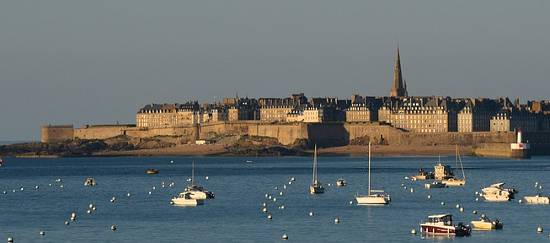 Saint Malo - walled city
Saint Malo - walled city | Short guide | Interactive map | Main tourist sites | More info |
 The
name "Brittany" derives from
the Britons who, back in the dark ages,
came south across the English Channel to seek refuge from the Anglo
Saxon invaders who were pushing them out of a large part of the island
of Great Britain.
The
name "Brittany" derives from
the Britons who, back in the dark ages,
came south across the English Channel to seek refuge from the Anglo
Saxon invaders who were pushing them out of a large part of the island
of Great Britain.In this historic past, other Britons fled to the west and south west of their own island, to Wales and Cornwall; and so it is that today, Brittany shares a historic culture with the other Celtic regions of northwest Europe.
Today, the French administrative region of Brittany covers four "departments", the Côtes d'Armor (22) in the north, Finistère (29) in the far west, Morbihan (56) in the south, and Ille et Vilaine (35) in the east, bordering on Normandy and the Loire valley area. Another department used to belong to the historic province of Brittany, and this was the Loire Atlantique (44), the area round the city of Nantes which used once to be the Breton capital, but is today no longer in the region.
The capital city of the modern Brittany region is Rennes, located in the central eastern part of the region; most of the major lines of communication between Brittany and Paris pass through Rennes, which is a large industrial and university city. Other important cities in the region are Brest, one of the two most important French naval ports, St Malo, an imposing walled city on the north coast, and Vannes, the capital of the Morbihan, with an atractive old town centre. Quimper, the capital of the Finistère, and St. Brieuc, the capital of the Côtes d'Armor, are less important. Lorient, in the Morbihan, was once a major shipping port trading with - as its name suggests - the Orient; but its shipping and ship-building industries have largely declined, and like other ports on the south coast of Brittany, is better known today for its yachting and yacht-building industry. It is also the venue for Brittany's annual Interceltiques music and culture festival.

Prehistoric megaliths at Carnac
In cultural terms, Brittany is very distinctive, with its own language and Celtic cultural tradition that set it apart from the rest of France. The Breton language, though not much used in everyday life, and not understood by most of the modern population, has made a comeback in recent years, and is taught in a lot of schools. Celtic traditions are alive or recalled today in Breton folk music, its Celtic festivals, and its many prehistoric monuments.
Reaching Brittany:
Train : by TGV from Paris Gare Montparnasse, train from many cities,Car: Motorway from Paris, Lille, or Calais, via Rouen and / or Rennes
Plane: Regional airports: Rennes, Brest, St. Brieuc, Nantes.
Accommodation:
Gites and holiday cottages in Brittany
Map of selected hotels on the Brittany coast
Main
tourist attractions in Brittany
35 Ille et Vilaine
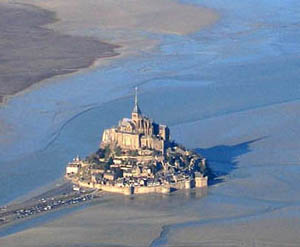 Mont
St. Michel. (Actually just in Normandy)
Fairytale like
medieval abbey and city perched on an offshore rock, off the
north-east coast of Brittany. A UNESCO world heritage site. One of the
most visited tourist attractions in France.
Mont
St. Michel. (Actually just in Normandy)
Fairytale like
medieval abbey and city perched on an offshore rock, off the
north-east coast of Brittany. A UNESCO world heritage site. One of the
most visited tourist attractions in France. - Saint Malo. The ancient city of pirates, historic St. Malo stands above the waves, encircled by its granite ramparts. Large aquarium. Also (most of the time) the Etoile du Roy, the replica of a frigate from 1745, originally built from the plans for HMS Blanford for the TV series Hornblower.
- Dinard. Classic tourist resort at the mouth of the river Rance, opposite Saint Malo.
- The tidal power-station on the Rance; unique tidal barrage generating electricity from the ebb and flow of the tide. Boat trips on the Rance.
- Fougères : medieval fortress city once part of the eastern defences of the duchy of Brittany. Ramparts, old town
- Vitré : great medieval fortress castle in the centre of this small historic town.
22 Côtes d'Armor
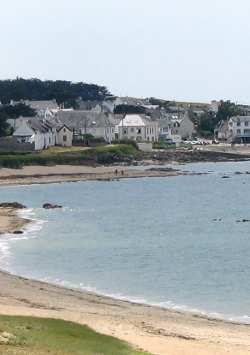
- The northern coast; dramatic rocky coastline with enchanting names like the Emerald coast and the Pink Granite coast, with small sandy beaches.
- Dinan - small town surrounded by ramparts, one of the most attractive towns in Brittany. Near Dinard.
- Paimpol - steam railway. Le Train du Trieux steam railway from Paimpol to Pontrieux. Operates most days late April to mid Sept. One service a day .
- Treguier: old town with stone and half-timbered houses, medieval cathedral
- Cap Fréhel ; one of the most beautiful natural sites in France
- Fort La Latte : impressive clifftop castle close to Cap Frehel
29 Finistère
- Brest: naval port city; Oceanopolis, one of the best aquariums in France
- Pointe du Raz : the western tip of Brittany, a rocky headland jutting out into the Atlantic breakers.
- Pont-Aven : the artists' village. Attracted many artists in the late 19th century, notably Paul Gauguin. the pretty village has an art gallery with 14 works by Gauguin, and other artists who worked here
- Quimper : small capital city of Finistère. Notable for its Musée des Beaux Arts, the best art gallery in Brittany, with works by Rubens, Boucher, Fragonard, Corot, Boudin, Gauguin, Whistler, Marquet and others. Gothic cathedral with medieval stained glass windows, porcelaine museum.
- Concarneau : major fishing port with historic walled old town on an island in the middle of the harbour.
56 Morbihan
- The southern coast; many long sandy beaches, and inlets popular with yachtsmen.
- Carnac: the most famous megalithic site in France; several prehistoric stone alignments and dolmens.
- Quiberon: attractive fishing port and resort at the end of a long peninsula. Sandy beaches.
- Josselin : One of the finest castles in Brittany. An early Renaissance castle built on the impressive base of a medieval fortress overlooking the river Oust. Guided tours
- The Nantes-Brest canal: those sections of it that survive are part of Brittany's popular inland waterway system, centered on the town of Redon
- Belle-Ile : attractive island off the south coast of Brittany. A place to escape from the cars. Citadel, beaches, hiking. Ferries from Quiberon and other ports.
- La Trinité sur mer : very popular yachting centre
- Lorient: once the port for the French East India company, the city now has a submarine base (guided visits) and submarine museum.
- Vannes : the old city of Vannes is largely encircled by medieval ramparts. The old centre is largely pedestrianized, and the narrow streets flanked by many old half-timbered houses. The cathedral dates from the 12th and 19th centuries. Art gallery.
44 Loire Atlantique
(which includes part of the historic province of Brittany)- Guérande: lovely old medieval walled city, famous for its coastal salt pans. Lots of arts and craft boutiques.
- Nantes : largest city in western France. Chateau of the Dukes of Brittany, cathedral, art gallery, impressive old city centre.
| Gites and cottages in Cotes d'Armor and in Finistere | Gites
and cottages in Morbihan and Ille & Vilaine |
B & in Brittany |
| Small hotels in Brittany | Small campsites in Brittany |
Site
search
About-France.com
What are you looking for ? Where do you want to go?
About-France.com
What are you looking for ? Where do you want to go?
Brittany,
lying in
the northwest corner of France, is one of the great historic provinces
of France. The most Atlantic of France's regions, Brittany is proud of
its Celtic heritage, that sets it apart from the rest of France. It it
enjoys a mild
climate somewhat warmer though not necessarily drier than the climate
of the southwest of England.
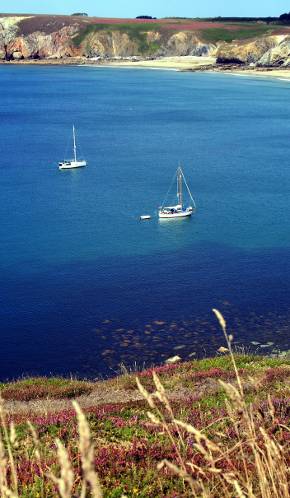
The west Brittany coast
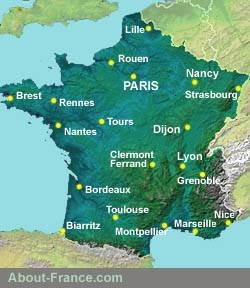

The rocky coast of Brittany
An independent website, About-France.com is an affiliate partner of selected external websites, and may receive a small commission on sales generated after users click through to a partner site.
Photo top of page by Stbucher
Click here for
low-cost car hire in France
low-cost car hire in France
About-France.com
is
an
independent website that does not track users and does not show any
personalised advertising, Affiliate links to selected relevant external
partner websites may lead to paymet of a small commission on
sales or bookings generated on
these sites.
Text and photos Copyright © About-France.com unless otherwise indicated

